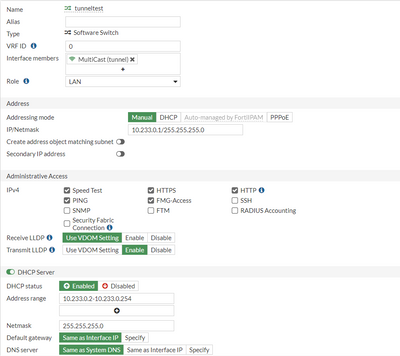- Support Forum
- Knowledge Base
- Customer Service
- Internal Article Nominations
- FortiGate
- FortiClient
- FortiADC
- FortiAIOps
- FortiAnalyzer
- FortiAP
- FortiAuthenticator
- FortiBridge
- FortiCache
- FortiCare Services
- FortiCarrier
- FortiCASB
- FortiConverter
- FortiCNP
- FortiDAST
- FortiData
- FortiDDoS
- FortiDB
- FortiDNS
- FortiDLP
- FortiDeceptor
- FortiDevice
- FortiDevSec
- FortiDirector
- FortiEdgeCloud
- FortiEDR
- FortiEndpoint
- FortiExtender
- FortiGate Cloud
- FortiGuard
- FortiGuest
- FortiHypervisor
- FortiInsight
- FortiIsolator
- FortiMail
- FortiManager
- FortiMonitor
- FortiNAC
- FortiNAC-F
- FortiNDR (on-premise)
- FortiNDRCloud
- FortiPAM
- FortiPhish
- FortiPortal
- FortiPresence
- FortiProxy
- FortiRecon
- FortiRecorder
- FortiSRA
- FortiSandbox
- FortiSASE
- FortiSASE Sovereign
- FortiScan
- FortiSIEM
- FortiSOAR
- FortiSwitch
- FortiTester
- FortiToken
- FortiVoice
- FortiWAN
- FortiWeb
- FortiAppSec Cloud
- Lacework
- Wireless Controller
- RMA Information and Announcements
- FortiCloud Products
- ZTNA
- 4D Documents
- Customer Service
- Community Groups
- Blogs
- Fortinet Community
- Knowledge Base
- FortiGate
- Technical Tip: How to forward Multicast traffic fr...
- Subscribe to RSS Feed
- Mark as New
- Mark as Read
- Bookmark
- Subscribe
- Printer Friendly Page
- Report Inappropriate Content
Created on
02-05-2023
10:20 PM
Edited on
04-17-2025
01:58 AM
By
![]() Jean-Philippe_P
Jean-Philippe_P
Description
This article describes how to forward Multicast traffic from one managed FortiAP to another managed FortiAP in tunnel mode.
Scope
FortiGate manages 2 FortiAPs. The FortiAPs have SSID: 'tunnel' in Tunnel mode with PC1: 10.233.0.3 connected to FAP1 and PC2: 10.233.0.4 connected to FAP2.
PC1 is generating MultiCast traffic (10.233.0.3 --> 234.5.6.7) and PC2 is expected to receive the traffic. Although both the PCs are connected to the same SSID however, PC2 does not receive the multicast traffic.
The reason is that the FortiAP SSID: 'tunnel' is in tunnel mode and will forward all traffic to the FortiGate. In FortiGate, the MultiCast policies do not allow the source and destination interface to be the same.
Solution
- The tunnel SSID needs to be added under a Software switch interface, as a software switch will copy the Multicast traffic and forward it back to all the FortiAPs.
- Create a tunnel mode SSID. Follow this link to create one: Setting up WiFi with a FortiAP.
Once created, make sure the IPV4 info is 0.0.0.0/0 and the DHCP server is disabled. - On the Tunnel SSID, enable IGMP SNOOPING and disable broadcast suppression or disable multicast enhancement:
config wireless-controller vap
edit "tunnel"
set ssid "MultiCast"
set multicast-enhance disable
set igmp-snooping enable
unset broadcast-suppression
next
end
-
Now, add the tunnel SSID to a Software switch. Follow the document below to achieve the same:
-
Once added, assign the desired IPV4 address to the interface of the software switch and enable the DHCP server on the Software switch interface.
-
Create a Multicast address with the destination IP/ IP range of Multicast addresses needed:
config firewall multicast-address
edit "MultiCastObject"
set start-ip 234.5.6.5
set end-ip 234.5.6.8
next
end
Setting up WiFi with a FortiAP Setting up WiFi with a FortiAP.
-
Create a MultiCast Policy and make sure to reference the MultiCast object inside the policy as it will be an 'any to any' policy and it is best practice to restrict the MultiCast addresses that are required:
config firewall multicast-policy
edit 1
set srcintf "any"
set dstintf "any"
set srcaddr "all"
set dstaddr "MultiCastObject"
next
end
-
Now, generate the MultiCast traffic from PC1 and PC2 on FAP2 should receive the traffic.
Verify it by running a sniffer for the interesting MultiCast traffic.
diagnose sniffer packet any 'host 234.5.6.7' 4 0 1
tunnel in 10.233.0.3.8910 -> 234.5.6.7.8910: udp 32 <---- Enter the tunnel SSID from FAP 1.
tunneltest in 10.233.0.3.8910 -> 234.5.6.7.8910: udp 32 <----- Enter the Software Switch.
wqtn.60.tunnel out 10.233.0.3.8910 -> 234.5.6.7.8910: udp 32
tunnel out 10.233.0.3.8910 -> 234.5.6.7.8910: udp 32 <------ Exits out via FAP1.
wqtn.60.tunnel out 10.233.0.3.8910 -> 234.5.6.7.8910: udp 32
tunnel out 10.233.0.3.8910 -> 234.5.6.7.8910: udp 32 <------ Exits out via FAP2.
tunnel out 10.233.0.3.8910 -> 234.5.6.7.8910: udp 32
havdlink0 in 10.233.0.3.8910 -> 234.5.6.7.8910: udp 32
Note: When users are connected through SSLVPN to FortiGate and the SSID is configured in tunnel mode to handle the multicast traffic between the APs, there is a possibility of multicast flooding in the internet-facing interface of FortiGate.
In such a case, it is essential to configure the SSID in Bridge mode instead of Tunnel.
When multicast traffic is in use, the data traffic can be bridged at the access point level to prevent multicast packets from reaching the client devices and causing flooding. This approach helps in reducing multicast-related overhead on the clients. This behavior does not require extensive configuration on the access point, as the bridging functionality is handled inherently at the AP level.
Related documents:
The Fortinet Security Fabric brings together the concepts of convergence and consolidation to provide comprehensive cybersecurity protection for all users, devices, and applications and across all network edges.
Copyright 2025 Fortinet, Inc. All Rights Reserved.

